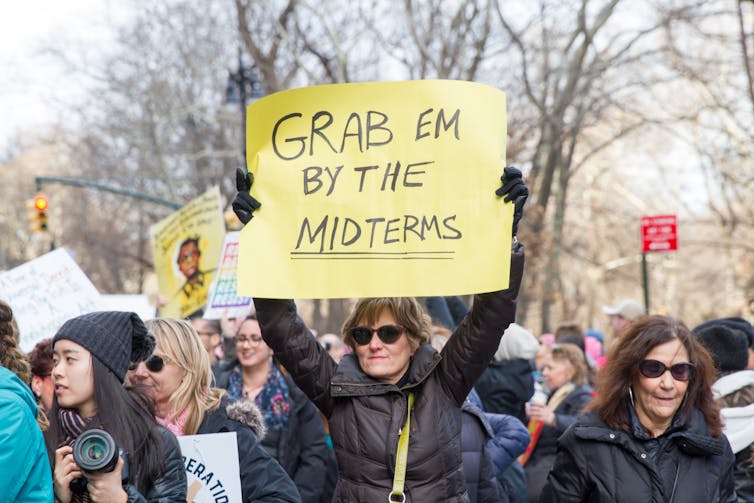The Conversation: How sex and gender influence how we vote
November 30, 2018
Share

Leading up to the recent midterm elections in the United States, pundits predicted women voters and candidates would alter the race.
There were, in fact, historic changes as more women than ever gained seats in U.S. Congress, breaking the 100-seat barrier. The winners included two Muslim women and two Native American women, both historic firsts.
 However, as we unpack and explain voting patterns, the narrative must move beyond stereotypical and biologically grounded explanations that focus on men and women as voting blocs. Instead, we must ask how gender orientations condition men’s and women’s politics.
However, as we unpack and explain voting patterns, the narrative must move beyond stereotypical and biologically grounded explanations that focus on men and women as voting blocs. Instead, we must ask how gender orientations condition men’s and women’s politics.
Several lessons from our ongoing research are instructive: First, gender strongly conditions the impact of sex on the vote. By “gender,” we mean the extent to which men and women identify with masculinity and femininity as sets of roles, traits and ideals.
The impact of gender on the vote differs from the effect of sex alone, in part because sex does not determine where you place yourself on a masculinity/femininity continuum.
Why some men are more liberal
Our work on measuring sex and gender in survey research, published last year in Political Behavior, shows that men who do not strongly identify with hypermasculinity are equally or more liberal than women on various issues, from same-sex marriage to social spending.
This implies that moderately masculine men, so to speak, are not in the Republican orbit because they do not share the party’s positions on the issues that defined the 2018 midterms: Immigration, gun rights, Brett Kavanaugh and the backlash against so-called “identity politics.”
In fact, all respondents whose gender self-placement veers from the most masculine or feminine endpoints of the scale tend to be more politically moderate than the hyper-masculine and hyper-feminine identifiers.
This means that highly feminine women — those who possess very traditional gender identities — are more conservative on some issues, including workplace discrimination, and are indeed open to the Republican platform.

The general message here is not novel in its recognition of multiple and cross-cutting identities and their importance to voting. Race, socioeconomic status and religion, for example, are other important influences on the vote.
What is novel about our research is that it identifies the patterns from an overlooked aspect of identity — gender. Sex and gender tend to be treated as synonymous both in “real life” and in research. Disentangling them is revealing the ways that our biology affects our behaviour less than previously thought.
Gender not a factor for some
The second big message coming from our research is that we must stop automatically treating gender as a “first-order” or “meta” identity that eclipses all other identities. For some voters, gender is not a strong pull on the vote or on political attitudes. Our research published last year in the Canadian Journal of Political Science finds that there are few male-female gaps in attitudes, and presumably voting, among people for whom gender is not important.
It’s only among those for whom gender is highly salient (and this is the case for a lot of people) that sex and gender have the potential to create gaps in attitudes and votes, producing a chasm in the electorate.
In the context of the 2018 midterms, a key observation is that sex and gender are more prominent in some campaigns than others.
Sometimes gender-based issues are at the top of the agenda, or high proportions of women candidates run. This can cue voters to think about gender issues when making their vote choices, a process called priming.
This helps explain the large partisan gaps between men and women and the unprecedented showing of women candidates in 2018. A record number of women candidates ran and won, and media, think tanks, researchers and political parties spent a lot of time discussing the anticipated “pink wave.”
#MeToo movement in play
What’s more, voters went to the polls soon after a Supreme Court confirmation process fought nearly exclusively over allegations that nominee Brett Kavanaugh had sexually assaulted several women. And this came after a year of intensive public action by the #MeToo movement, which has illuminated the widespread sexual violence and harassment faced by women.
It’s clear the electoral environment contributes to the politicization of social divisions. When campaigns focus on other issues or other types of candidates, different electoral divides define the vote, and sex and gender may take a back seat to partisanship, race or religion.
Traditionally, we talk about women voters as if they are unique and act as a bloc. But not all women vote the same, and women don’t uniformly feel the same about issues, parties or candidates over time.
Context matters. It activates identities in the minds of voters, and campaigns provide cues for the types of considerations that will influence voters at the ballot box. The 2018 midterm election campaign activated sex, but it also activated gender, and the strength of a voter’s masculinity and femininity no doubt had a discernible impact on how they cast their ballots.![]()
__________________________________
Elizabeth Goodyear-Grant is an associate professor the Department of Political Studies at Queen’s University, director of Queen’s Institute of Intergovernmental Relations, and director of the Canadian Opinion Research Archive. Amanda Bittner is an associate professor in the Department of Political Science at Memorial University of Newfoundland.
The Conversation provides news and views from the academic and research community. Queen’s University is a founding partner. Queen’s researchers, faculty, and students are regular contributors.
The Conversation is seeking new academic contributors. Researchers wishing to write articles should contact Melinda Knox, Associate Director, Research Profile and Initiatives, at knoxm@queensu.ca.
This article is republished from The Conversation under a Creative Commons license. Read the original article.